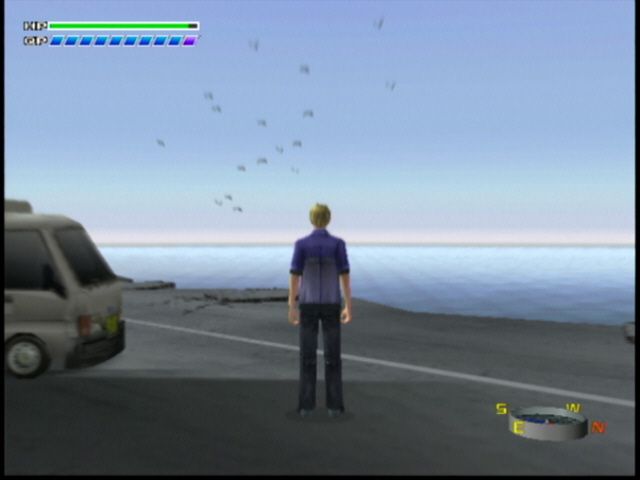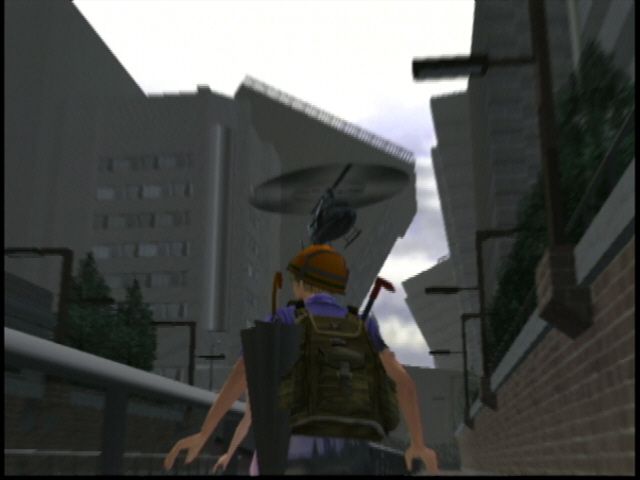Retro Replay Review
Gameplay
Disaster Report delivers a tense, immersive gameplay experience that blends adventure and survival horror elements in a unique way. You step into the shoes of Keith Miyamoto, a reporter stranded on Capital City Island in the midst of a catastrophic earthquake. There are no combat mechanics here—instead, every decision revolves around careful resource management, environmental awareness, and puzzle-solving. The fixed camera angles echo classics like Alone in the Dark, forcing you to gauge distances and timing before attempting each precarious step.
Inventory management is at the core of your survival. You’ll scavenge for supplies such as water, food, and makeshift tools, and you must choose wisely which items to carry. The ability to combine objects—for example, attaching a lamp to a helmet—adds a layer of creativity to problem-solving. Every item you find could mean the difference between safely navigating a crumbling overpass or facing a fatal collapse.
Water taps scattered throughout the ruins serve as both hydration points and save stations, reinforcing the constant tension in Disaster Report. Keith’s vulnerability is palpable: he can only withstand so much stress before becoming fatigued or dehydrated. You’ll pause frequently to assess damage, restore health, and plan the safest path through unstable structures. This meticulous pacing makes each inch of progress feel earned and heightens the sense of accomplishment when you finally clear a particularly tricky obstacle.
Beyond the core survival mechanics, the game also incorporates environmental puzzles that require keen observation. You may need to clear debris with improvised tools, reroute power to open locked doors, or navigate flooded tunnels by manipulating valves. These challenges never feel arbitrary—they’re organically tied to the unfolding disaster scenario, maintaining immersion as you strive to escape the island or rescue stranded civilians.
Finally, the continuing aftershocks keep you on edge. At any moment, a bridge you’re crossing can give way, or rubble might shift beneath you. This unpredictability ensures that no two play sessions are exactly alike, encouraging cautious exploration and replay to uncover hidden items, alternate routes, or survivor stories you might have missed.
Graphics
The visual presentation in Disaster Report is both stark and atmospheric, effectively conveying the scale of devastation wrought by the earthquake. Collapsed buildings, twisted girders, and piles of rubble are all rendered with a level of detail that underscores the game’s survival ethos. Light and shadow play crucial roles here; darkened doorways hint at unseen dangers, while flickering emergency lights guide your path through debris-strewn corridors.
Character models may appear dated by modern standards, but they fit the game’s gritty tone. Keith’s weary expressions and the frayed clothing on NPCs reflect the harsh conditions on Capital City Island. Environmental textures—cracked concrete, exposed rebar, and fallen signage—help immerse you in the crumbling urban landscape. The attention to detail in the destruction is impressive, from shattered glass to dust clouds kicked up by aftershocks.
While the fixed camera angles sometimes obscure your view, they also contribute to the cinematic tension. You’ll find yourself peering around corners, unsure whether the path ahead is clear or about to collapse. The occasional slowdown in frame rate during more dynamic sequences can be forgiven, as these moments heighten the chaotic feel of the quake and emphasize the fragility of your surroundings.
The game’s sound design complements the visuals perfectly. The distant rumble of shifting earth, the creak of bending steel, and the muffled cries of survivors combine to create a haunting audio backdrop. Ambient effects such as dripping water in flooded tunnels or the whine of a broken power generator enhance the sense of dread, making each step through the ruins an exercise in survival horror.
In terms of art direction, Disaster Report strikes a balance between realism and stylized urgency. The color palette—dominated by grays, browns, and occasional splashes of emergency red—reinforces the game’s dire atmosphere without overwhelming the senses. Together, the visuals and audio immerse you in a world on the brink of collapse, where every decision is a life-or-death gamble.
Story
At the heart of Disaster Report lies the narrative of Keith Miyamoto, a Los Angeles reporter sent to Capital City Island for a routine assignment that quickly turns into a fight for survival. As the earthquake hits, Keith’s lone journey becomes entwined with the fate of the island’s residents. His objective is twofold: escape the disaster zone and uncover the truth behind the catastrophe that strikes without warning.
The storytelling unfolds through environmental details, character interactions, and documented clues scattered across the map. You’ll discover shredded newspapers, hastily scribbled notes, and recorded messages that hint at corporate conspiracies or governmental negligence. These breadcrumbs come together slowly, rewarding observant players with a deeper understanding of the events that led to the island’s downfall.
Interactions with fellow survivors add emotional weight to your escape. NPCs range from panicked tourists to local workers familiar with the island’s infrastructure, each with unique backstories and needs. Helping them often involves detours or time-sensitive decisions: do you stop to rescue someone trapped in a collapsed subway car, or push on to secure an escape route? These moral choices don’t follow a strict “good vs. evil” dichotomy but instead present realistic dilemmas that underscore the chaos of a large-scale disaster.
Dialogue is sparse but effective, capturing the urgency and confusion of a calamity in progress. Keith’s calm, investigative demeanor contrasts with the fear and despair of civilians, creating compelling character dynamics. Through these exchanges, you gain insight into the island’s hidden dangers—from structurally unsound zones to secret facilities that hint at darker motivations behind the quake.
The narrative pacing mirrors the gameplay’s tension, alternating between breathless escapes and quieter moments of reflection. You might pause in a makeshift shelter to review new evidence, only to be jolted back into action by a sudden aftershock. This ebb and flow keeps the plot engaging, ensuring you’re as invested in uncovering the story’s mysteries as you are in preserving Keith’s life.
Overall Experience
Disaster Report stands out as a survival adventure that eschews traditional combat for environmental storytelling and resource-based challenges. Its blend of fixed camera perspective, inventory crafting, and atmospheric tension makes it a memorable entry in the genre. While some controls feel dated and the visuals show their age, these factors do little to diminish the game’s core strengths.
Players seeking a narrative-driven experience will appreciate the game’s pacing and the depth of its unfolding mysteries. The moral choices you make resonate long after the credits roll, and the absence of conventional enemies places all the focus on the unstoppable force of nature itself. Every crumbling staircase and makeshift ladder becomes an obstacle that tests both your puzzle-solving skills and your nerve.
Replay value is high, thanks to multiple routes, optional rescues, and hidden evidence that reveal different facets of the disaster. Exploring thoroughly and experimenting with item combinations can lead to entirely new experiences, encouraging you to return even after a successful escape. The game rewards careful planning and curiosity, making each replay feel fresh and fraught with new dangers.
If you’re drawn to survival scenarios that prioritize atmosphere and realism over action, Disaster Report delivers an unforgettable journey through a world on the brink. Its thoughtful design, compelling narrative, and relentless tension offer a distinctive gaming experience—one that will leave you acutely aware of how quickly the ground beneath your feet can give way.
Ultimately, Disaster Report succeeds as both an adventure title and a survival horror experience, crafting a narrative where every choice matters and every step could be your last. For players eager to test their wits and nerves in the face of natural disaster, this game offers a gripping, immersive ride from start to finish.
 Retro Replay Retro Replay gaming reviews, news, emulation, geek stuff and more!
Retro Replay Retro Replay gaming reviews, news, emulation, geek stuff and more!









Reviews
There are no reviews yet.